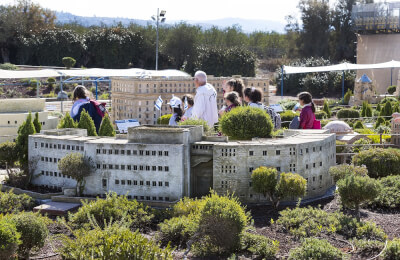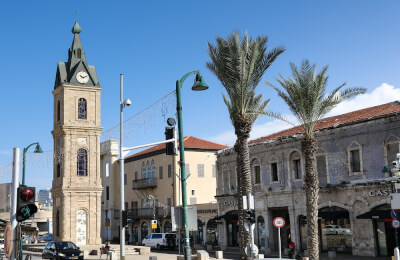
9. Stalactite caves and monasteries Promotion
 175₪
175₪
 175₪
175₪
Monkey Park Promotion
 150₪
150₪
 150₪
150₪
167. On the road of monasteries and wine Promotion
 175₪
175₪
 175₪
175₪
177. Sweet Jerusalem Promotion
 175₪
175₪
 175₪
175₪
135. Pearls of the coastal lowlands Promotion
542. Christmas Tel Aviv Promotion
 150₪
150₪
 150₪
150₪
We also found excursions from other cities that are close to your departure city
Other excursions that also deserve your attention
# The Monastery of Latrun: A Beacon of Tranquility in Israel's Heartland
Nestled amid the rolling hills of central Israel, the Monastery of Latrun stands as a testament to faith, history, and the enduring spirit of community. This serene and captivating site, often overshadowed by more famous destinations, offers a unique blend of religious significance, architectural splendor, and historical intrigue. In this exploration of the Monastery of Latrun, we will delve into its rich history, admire its architectural beauty, and uncover intriguing facts that make it a hidden gem worth discovering.
## A Glimpse into History
The Monastery of Latrun, also known as the Trappist Monastery of the Silent Monks, is situated approximately 15 miles (24 kilometers) west of Jerusalem. Its location is not only picturesque but also steeped in history. To truly appreciate this site, let's embark on a journey through time:
**1. Ancient Roots:** The history of Latrun stretches back to biblical times when the region was known for its vineyards and olive groves. The name "Latrun" is believed to be derived from the Hebrew word "Lidrot," which means "to hide."
**2. Military Significance:** The strategic location of Latrun has made it a site of great military importance throughout history. It overlooks the Ayalon Valley, which has been a key passage between the coastal plain and the Jerusalem mountains.
**3. The Monastic Legacy:** The modern history of the Monastery of Latrun begins in the late 19th century when it was established by Trappist monks from France. These monks, known for their vow of silence and rigorous daily routines, played a pivotal role in the development of the area.
**4. Turbulent Times:** The monastery's history is marked by periods of tranquility and turmoil. During World War II, the monks were forced to leave, and the site served as a military base. Later, it became a focal point of conflict during the 1948 Arab-Israeli War.
**5. A New Beginning:** After the war, the Trappist monks returned to Latrun, rebuilding the monastery and vineyards. Today, they continue their monastic life, producing high-quality wine and offering a serene haven for reflection and worship.
## Architectural Splendor
While the Monastery of Latrun is renowned for its spiritual significance, it is also celebrated for its architectural beauty. The buildings themselves are a testament to the craftsmanship and dedication of the monks. Let's explore the architectural highlights:
**1. The Church:** The heart of the monastery is its exquisite church, a place of prayer, reflection, and worship. The church's interior features intricate stained glass windows, ornate altars, and serene chapels. Its tranquil ambiance invites visitors to pause and contemplate.
**2. The Bell Tower:** One of the most recognizable features of Latrun is its soaring bell tower. This impressive structure stands as a symbol of the monastery and has become an iconic image of the site. The bells, with their melodious chimes, mark the passage of time and call the faithful to prayer.
**3. The Cloister:** The monastery's cloister is a serene and contemplative space. Here, the monks maintain their vow of silence, fostering an atmosphere of tranquility and reflection. The peaceful gardens within the cloister provide a place for meditation and solitude.
**4. The Vineyards:** Latrun is renowned for its vineyards and wine production. The monks produce a variety of wines, including red, white, and rosé, using traditional methods that have been passed down through generations.
**5. The Guesthouse:** The monastery also welcomes visitors from all walks of life. It offers a guesthouse where guests can experience the peaceful surroundings, join in communal prayer, and enjoy the fruits of the monks' labor, including their acclaimed wine.
## Intriguing Facts About the Monastery of Latrun
1. **Vineyards and Wine Production:** The wine produced at Latrun has garnered international recognition for its quality. The monks take great care in tending to the vineyards and producing wine that reflects the region's terroir.
2. **Silence as a Way of Life:** The Trappist monks at Latrun are known for their vow of silence, which is an integral part of their daily routine. This commitment to silence fosters an environment of deep contemplation and prayer.
3. **Interfaith Dialogue:** The Monastery of Latrun has been involved in interfaith dialogue and cooperation. It has welcomed visitors of various religious backgrounds and has played a role in promoting understanding and harmony among different faiths.
4. **Peaceful Retreat:** Many visitors to Latrun find it to be a place of respite from the hustle and bustle of daily life. Its serene surroundings and sense of tranquility make it an ideal destination for those seeking solace and reflection.
5. **Museum of the Jewish Soldier:** Adjacent to the monastery is the Museum of the Jewish Soldier, which commemorates the sacrifices made by Jewish soldiers in various wars and conflicts. The juxtaposition of the museum and the monastery highlights the complex history of the site.
## Planning Your Visit
For those planning to visit the Monastery of Latrun, there are several considerations to keep in mind:
**1. Dress Modestly:** When visiting religious sites, it is respectful to dress modestly. Ensure that your attire covers your shoulders and knees, particularly if you plan to enter the church.
**2. Respect the Monks' Silence:** Remember that the Trappist monks at Latrun observe a vow of silence. Maintain a quiet and respectful demeanor during your visit.
**3. Check Opening Hours:** The monastery has specific visiting hours, and it may be closed to visitors during certain times or events. Check the monastery's website or contact them in advance to confirm opening hours.
**4. Wine Tasting:** If you're interested in wine, don't miss the opportunity to sample the monastery's wines. They are available for purchase at the monastery's shop.
**5. Guided Tours:** Consider joining a guided tour to gain deeper insights into the history, spirituality, and architecture of the Monastery of Latrun. Knowledgeable guides can provide valuable context.
## In Conclusion
The Monastery of Latrun is a place where history, spirituality, and craftsmanship converge. Its tranquil surroundings and architectural beauty offer a respite from the rush of modern life, inviting visitors to pause and reflect. This hidden gem is a reminder of the enduring power of faith and the role it plays in shaping both the past and the present.
A visit to the Monastery of Latrun is a journey into a world where time seems to stand still—a world where the solemn tolling of bells and the rustle of leaves in the cloister remind us of the importance of silence and contemplation. Whether you seek a deeper connection with your faith or simply a peaceful retreat from the world, Latrun beckons with open arms, inviting you to explore its history, savor its wine, and embrace its serenity.























